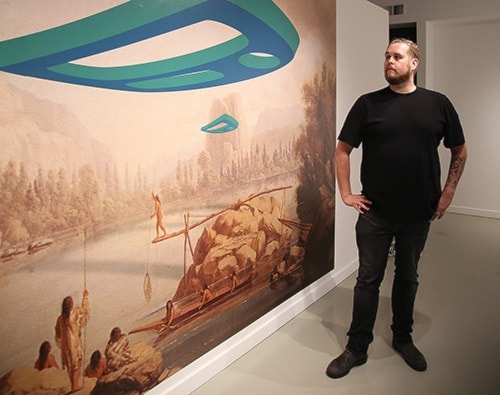Sonny Assu considers his art to be autobiographical; he explores his identity and the history of his people.
One such story from his grandmother translated into the piece Leila’s Desk. Assu’s grandmother was the first indigenous person allowed to go to high school in Campbell River. On her first day, one of her Grade 9 classmates left a bar of soap on her desk and called her a dirty Indian.
Assu said that experience stuck with her until she passed away. She associated different feelings with each re-telling of the story, sometimes inquisitive, sometimes angry, sad or humorous, each time revealing another side of the story to Assu.
“What a phenomenal experience to be granted that right, but to be slapped in the face with racism, by a child, was devastating,” he said.
Assu recreated the moment that his grandmother remembered so well, refinishing a 1930s school desk, leafing it with copper and placing a bar of the exact brand of soap, that he found on eBay, on the desk.
When she saw the pictures, Assu said she was thrilled that someone had told her story.
The piece, as well as more of Assu’s art, is on display at the Campbell River Art Gallery until July 21.
“I hope these pieces in that show become an educational experience for the people that view them, especially that one because it has such strong connections to what this place is,” Assu said.
Assu’s path to becoming a professional artist began in vigour in junior high with drawings of super heroes. As he completed his secondary education he explored music and drama as well.
“When I first decided to go back to school it was because I was fed up of working in a shoe store,” he said.
After approaching his band for funding, Assu enrolled at Kwantlen University College (now Polytechnic). He spent his first two years of post-secondary exploring printmaking and gaining technical expertise. It was in his final year there that he was encouraged to explore how First Nations art could be incorporated into his style.
He had been sketching a raven when one of his instructors approached him and told him he couldn’t explore First Nations art because he wasn’t a First Nations person. When Assu assured him that he was First Nations, the instructor said he should explore the style because it had the potential to be a powerful artistic movement.
“With that push I started to investigate further the iconography from my culture,” he said.
Upon transferring to Emily Carr University he learned more conceptual theory and had the chance to begin his exploration into combining traditional First Nations art and symbols with his current style and artistic vision.
Assu has connections to both the Campbell River and Cape Mudge First Nations. However, Assu’s art is not what you might expect. He combines his First Nation identity with his 80s Saturday morning cartoons, sugary breakfast cereal, comic book upbringing.
“The artwork I make is referencing those shapes and some of those colours but I am taking it to a different place,” he said. “I am abstracting it.”
Assu has his hands in many different disciplines. The exhibition in Campbell River displays paintings, digital intervention work and installation based art.
The digital interventions pieces are a recent addition to Assu’s portfolio. He takes paintings of the historical West Coast landscape and super-imposes 3D First Nations symbols. He then titles the works humorously to bring awareness to the indigenous presence on the land.
Each of Assu’s pieces address what he calls ‘the hidden history’ of the First Nations people.
“Installation, for me, is a way to create a story based on family narratives that speak to that hidden history, that really give a face to the issues,” he said.
“Previous to the Truth and Reconciliation report, not many Canadians understood that there were faces to those issues…Me bringing that human face to the elements, I think will invoke Canadian compassion.”
